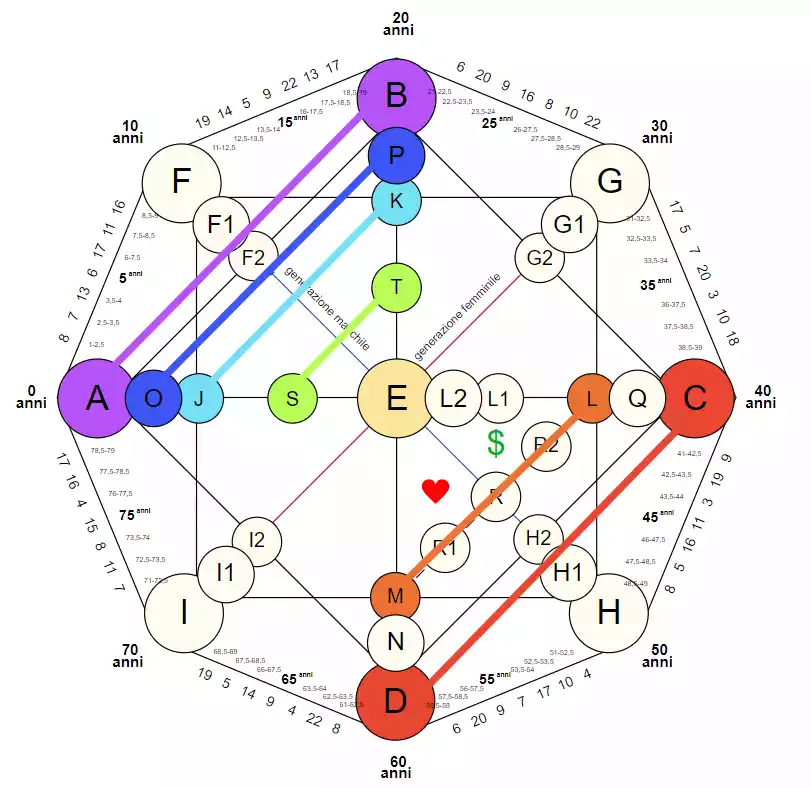Summary
Chakras are fundamental energy centers in the human body, a concept rooted in Eastern spiritual traditions and now widely recognized in Western holistic practices as well. These energy vortices, whose name in Sanskrit means "wheel" or "disc," are connection points between the physical and subtle bodies, through which life energy, or prana, flows freely when they are in balance.
In the matrix of destiny, chakras assume a crucial role, representing not only energy centers but also nodal points through which our life path manifests. The analysis of the chakra within this system offers a deep understanding of our karmic potentials and challenges.
The 7 main chakras
The human energy system comprises seven main chakras, each associated with specific physical, emotional and spiritual functions:
- Muladhara (root chakra): Of red color, is located at the base of the spine. It represents security, confidence and stability. It is the base for the other energy centers.
- Svadhisthana (sacral chakra): Of orange color, is located below the navel. It is related to pleasure, creativity and sexuality.
- Manipura (solar plexus chakra): Of yellow color, is located in the stomach area. It governs will, personal power and achievement.
- Anahata (heart chakra): Green in color, located in the center of the chest. It represents love, compassion and relationships.
- Vishuddha (throat chakra): Blue in color, it is located in the throat. It concerns communication, self-expression and creativity.
- Ajna (third eye chakra): Indigo in color, it is found between the eyebrows. It is associated with intuition, wisdom and extrasensory perception.
- Sahasrara (crown chakra): Purple in color, it is located on the top of the head. It represents spiritual connection and enlightenment.
These seven energy centers form a complex map of our being, influencing every aspect of our existence, from the most basic bodily functions to the highest spiritual experiences.
The chakras in the Matrix of Destiny
Correspondence between chakras and colors in the matrix
In the destiny matrix, each chakra is represented by a specific color, creating a visual correspondence that facilitates interpretation and analysis. This color association is not random, but reflects the vibrational frequencies of each energy center:

- Muladhara: red
- Svadhisthana: orange
- Manipura: yellow
- Anahata: green
- Vishuddha: blue
- Ajna: indigo
- Sahasrara: purple
Tasks to activate the energies of the matrix
Energy 1-7
The first seven energies in the destiny matrix correspond to the fundamental chakras and require specific work to activate them:
- Energy 1 (Muladhara): Focus on the creation of ideas and their practical implementation.
- Energy 2 (Svadhisthana): Developing intuition and deepening self-knowledge.
- Energy 3 (Manipura): Cultivating flexibility and wisdom in relationships.
- Energy 4 (Anahata): Taking responsibility and leadership in one's life.
- Energy 5 (Vishuddha): Learning and transmitting knowledge, creating order.
- Energy 6 (Ajna): Making choices based on love and inner harmony.
- Energy 7 (Sahasrara): Set clear goals and keep active in their pursuit.
Energy 8-14
Energies 8 to 14 in the destiny matrix represent a deeper level of personal and spiritual development:
- Energy 8: Observe the law of karma and maintain balance.
- Energy 9: Practice retreat and contemplation to gain wisdom.
- Energy 10: Learning to flow with the natural cycles of life.
- Energy 11: Invest energy in personal development and helping others.
- Energy 12: Develop a broader, altruistic perspective.
- Energy 13: Completing cycles and projects, practicing detachment.
- Energy 14: Finding the balance between extremes while cultivating creativity.
Energy 15-22
The last energies of the matrix represent the highest levels of spiritual awareness and realization:
- Energy 15: Accepting all aspects of self, overcoming dependencies and limitations.
- Energy 16: Embracing the lessons of fate as opportunities for growth.
- Energy 17: Develop and share your unique talents.
- Energy 18: Overcoming fears by exploring the psyche and the unconscious.
- Energy 19: Cultivating optimism and generosity, inspiring others.
- Energy 20: Making bold decisions, trusting intuition.
- Energy 21: Expanding consciousness beyond conventional limits.
- Energy 22: Living in the present, following one's inner joy.
Description of individual chakras
Muladhara (root chakra)
Muladhara, located at the base of the spine, is the foundation of the energy system. In the matrix of destiny, this red chakra symbolizes our connection to the Earth, stability and security. A balanced Muladhara in the matrix indicates a solid foundation for personal and spiritual development, manifesting as a sense of grounding and confidence in one's ability to survive.
Svadhisthana (sacral chakra)
Located just below the navel, Svadhisthana is represented by the color orange in the matrix of destiny. This chakra governs creativity, sexuality and emotions. Balanced energy at this point in the matrix suggests a rich emotional life and a capacity for fluid creative expression, elements crucial to our overall well-being and the fulfillment of our deepest desires.
Manipura (solar plexus chakra)
The Manipura, by yellow color, is located in the solar plexus region. In the matrix of destiny, this chakra represents our personal power, self-esteem and willpower. A strong Manipura in the matrix indicates the ability to assert oneself in the world, to pursue one's goals with determination and to manifest one's intentions in material reality.
Anahata (heart chakra)
Anahata, the heart chakra, is represented by the color green in the matrix of destiny. This energy center is the bridge between the lower chakras, related to materiality, and the higher chakras, connected to spirituality. A balanced Anahata in the matrix manifests as the ability to love unconditionally, feel compassion and establish harmonious relationships with both oneself and others.
Vishuddha (throat chakra)
Vishuddha, located in the throat region, is represented by the color blue in the matrix of destiny. This chakra governs communication, self-expression and vocal creativity. A well-aligned Vishuddha in the matrix indicates the ability to express one's truth with clarity and authenticity, facilitating effective and creative communication in all spheres of life.
Ajna (third eye chakra)
Ajna, known as the third eye chakra, is associated with the color indigo in the matrix of destiny. This energy center is linked to intuition, clairvoyance and inner wisdom. A powerful Ajna in the matrix suggests a strong connection with one's own inner guidance and the ability to perceive realities beyond the physical world, facilitating wise decisions and a deep understanding of one's life.
Sahasrara (crown chakra)
Sahasrara, the crown chakra, is represented by the color purple or white in the matrix of destiny. Located on the top of the head, this chakra symbolizes our connection with the divine And cosmic unity. An open and balanced Sahasrara in the matrix indicates a high level of spiritual awareness, a deep understanding of one's life purpose and the ability to transcend the limitations of the material world.
Connection between hormonal system and chakra
Role of the endocrine system
The endocrine system plays a fundamental role in our physical and emotional well-being, regulating numerous bodily functions through the production and release of hormones. In the matrix of destiny, the connection between the endocrine system and the chakras reveals a profound interaction between subtle energy and physiology.
The endocrine glands, such as the pineal, pituitary, thyroid and adrenals, are closely associated with the corresponding chakras. This correlation underscores the importance of maintaining energy balance to support optimal hormonal health.
Correlation between glands and chakras
In the matrix of destiny, each chakra is associated with specific endocrine glands:
- Muladhara: adrenal glands
- Svadhisthana: gonads (ovaries and testes)
- Manipura: pancreas
- Anahata: thyme
- Vishuddha: thyroid and parathyroids
- Ajna: pineal gland
- Sahasrara: pituitary gland
This correlation offers a unique perspective on our holistic health, allowing us to understand how the energetic state of the chakras can affect hormonal functioning and vice versa.
Mutual influence between chakras and hormones
The interaction between chakra and hormonal system in the matrix of destiny is bidirectional. An imbalanced chakra can manifest as hormonal dysfunction, while a hormonal imbalance can in turn affect the energy of the corresponding chakra.
For example, an imbalance in the throat chakra (Vishuddha) could be reflected in thyroid problems, while thyroid-related hormonal problems could manifest as energy blockages in the Vishuddha. This understanding holistic offers new perspectives for approaches integrated to health and well-being.
Harmonious development of the chakras
Gradual approach starting from the root chakra
In the matrix of destiny, the harmonic development of the chakras follows an ascending path, starting from Muladhara (root chakra) and progressing upward. This gradual approach is essential for building a solid and stable energy base.
Starting with the root chakra means working on security, stability and connection to the material world. In the matrix, this translates into a vibrant, well-grounded red energy that provides the foundation for personal and spiritual evolution.
Working on karmic tasks
The matrix of destiny reveals our karmic tasks, often associated with the lower chakras. These tasks represent life lessons that we must face and overcome in order to progress on our evolutionary path.
Working on karmic tasks in the matrix involves:
- Identify blocked or imbalanced energies in the lower chakras
- Understand the lessons associated with these blocks
- Taking concrete actions to overcome karmic challenges
This process of karmic resolution in the matrix of destiny is essential to unlock the full energy potential of the upper chakras.
Progression to the upper chakras
As karmic tasks are resolved and the lower chakras are balanced, the matrix of destiny shows a natural progression toward the higher chakras. This upward movement manifests as:
- An expansion of spiritual awareness
- Greater insight and connection with inner guidance
- An increase in the ability to manifest one's intentions in the world
In the matrix, this progression is reflected in a more balanced distribution of energies among all chakras, with harmonious activation of higher centers such as Ajna (third eye) and Sahasrara (crown).
Frequently Asked Questions
How do I calculate the Matrix of Destiny?
To calculate the Matrix of Destiny, you need to use our calculator by clicking here.
It is the most advanced and comprehensive Destiny Matrix calculator you will find.
What else can I calculate with the Matrix of Destiny?
With the Destiny Matrix you can also calculate your talents, your karmic debts, your comfort point and harmony, your relationship zone, your finance zone, the prognosis of your past and future life, and so much more.
Does each person have the same Matrix?
No, each person has a different matrix. Matrices can be the same if you are born on the same day, month and year, but even if you have the same energies, the meaning acmbia based on harmonization.
